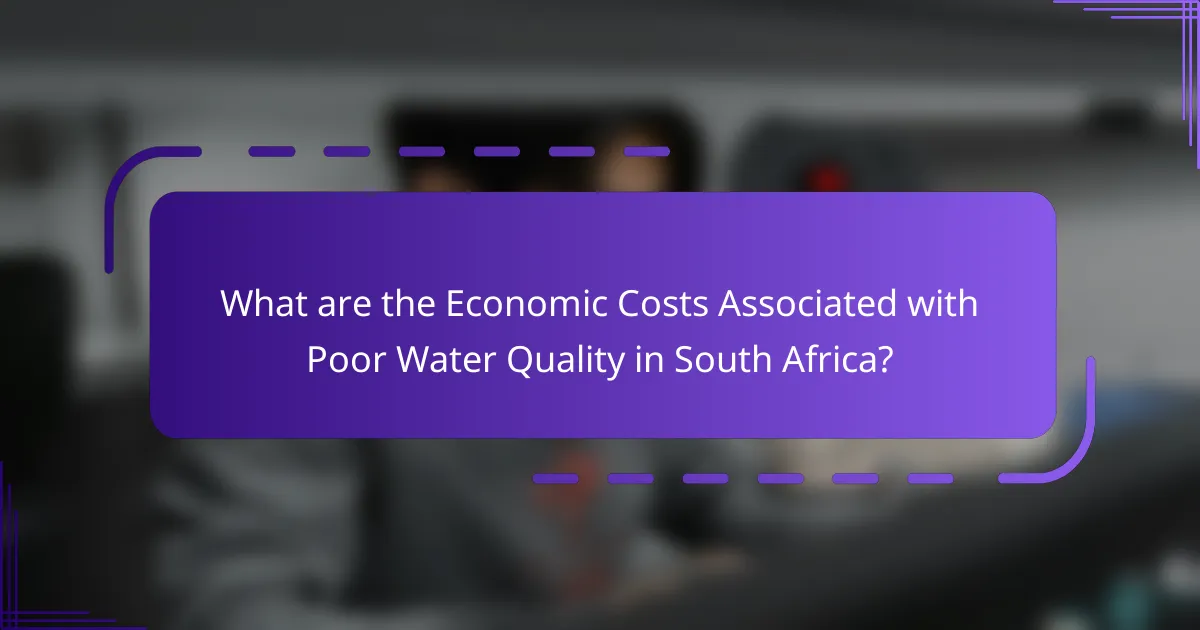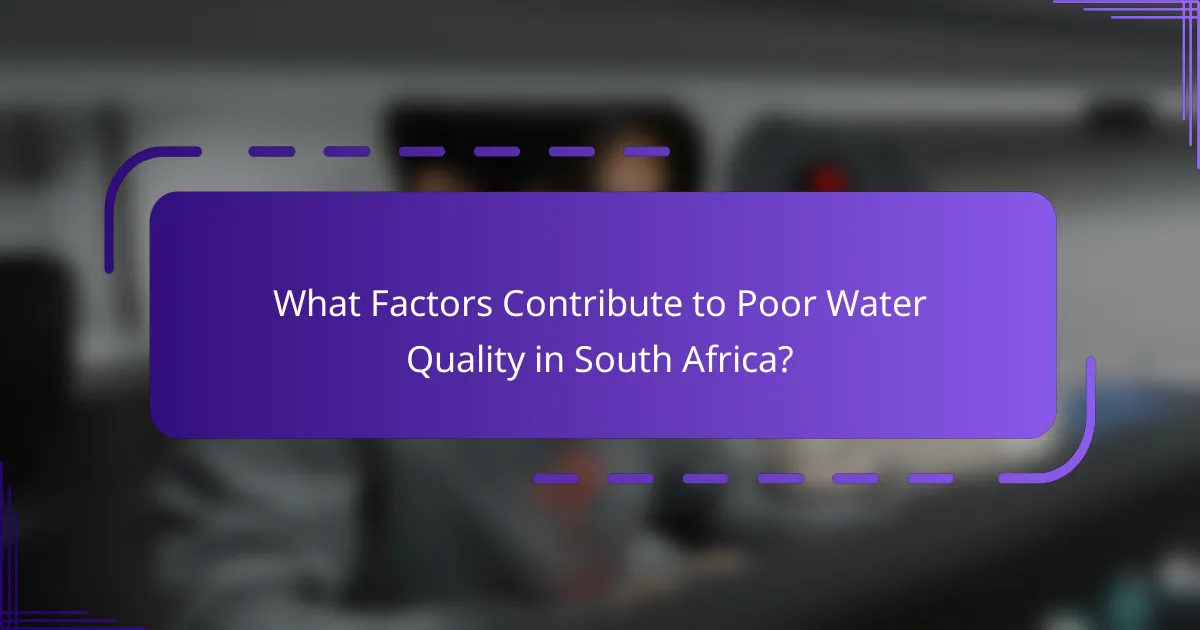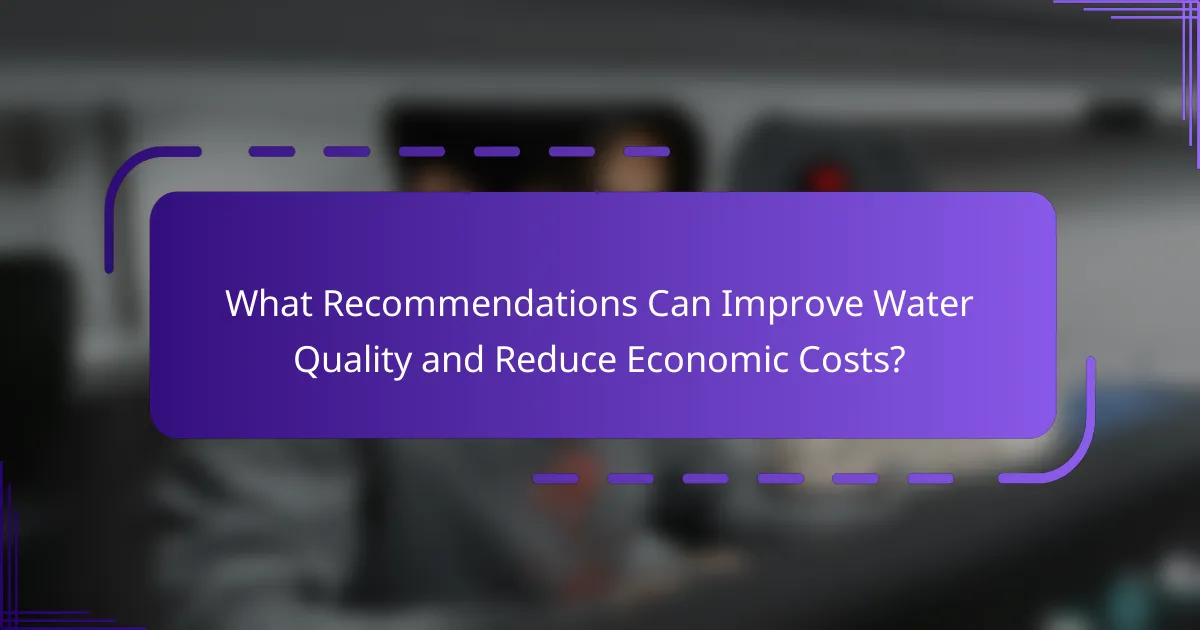The economic costs of poor water quality in South Africa are substantial, primarily arising from healthcare expenses related to waterborne diseases, agricultural productivity losses, and impacts on tourism. Contaminated water sources lead to illnesses such as cholera and dysentery, with the government spending millions annually on treatment. Contributing factors include pollution from industrial discharge, agricultural runoff, inadequate infrastructure, and the effects of climate change, resulting in approximately 50% of the country’s rivers being polluted. Implementing effective water management practices, such as infrastructure upgrades and sustainable farming, can mitigate these issues and improve public health and economic stability. The article provides a comprehensive analysis of these challenges and offers recommendations for enhancing water quality in South Africa.

What are the Economic Costs Associated with Poor Water Quality in South Africa?
The economic costs associated with poor water quality in South Africa are significant. These costs include healthcare expenses due to waterborne diseases. Poor water quality contributes to the prevalence of illnesses such as cholera and dysentery. The South African government spends millions on treating these diseases annually. Additionally, reduced agricultural productivity results from contaminated water sources. Farmers face crop failures and livestock losses, impacting food security. The tourism sector also suffers as polluted water bodies deter visitors. Infrastructure maintenance costs increase due to the need for water treatment facilities. Overall, the economic burden from poor water quality is estimated to be in the billions annually.
How does poor water quality impact public health and safety?
Poor water quality significantly impacts public health and safety. Contaminated water can lead to waterborne diseases such as cholera and dysentery. According to the World Health Organization, these diseases cause millions of deaths annually. In South Africa, inadequate sanitation and polluted water sources exacerbate health risks. The Department of Water and Sanitation reports that unsafe drinking water contributes to high morbidity rates. Vulnerable populations, including children and the elderly, are particularly at risk. Poor water quality also strains healthcare systems, increasing economic costs. Addressing these issues is crucial for improving public health outcomes.
What are the direct health costs incurred due to waterborne diseases?
Direct health costs due to waterborne diseases include medical treatment expenses, hospitalization fees, and lost productivity. In South Africa, these costs can reach billions annually. For instance, the World Health Organization estimates that waterborne diseases cause approximately 500,000 deaths each year globally. These diseases often lead to significant healthcare burdens, including outpatient visits and long-term health complications. The financial impact on families and healthcare systems is substantial. Addressing water quality can reduce these costs significantly. Improved water infrastructure is essential for public health and economic stability.
How does access to clean water affect community well-being?
Access to clean water significantly enhances community well-being. It reduces the incidence of waterborne diseases, which improves public health. For instance, access to clean water can lower child mortality rates by up to 50%. Clean water also boosts productivity by decreasing the time spent on water collection. Communities with reliable water sources see improvements in educational attendance. Studies show that girls are more likely to attend school when clean water is accessible. Furthermore, economic development is supported as clean water attracts businesses. In South Africa, the economic burden of poor water quality is estimated at 7% of GDP. Access to clean water thus underpins health, education, and economic stability in communities.
What economic sectors are most affected by poor water quality?
The economic sectors most affected by poor water quality include agriculture, fisheries, and tourism. Agriculture suffers due to reduced crop yields and livestock health issues. Poor water quality can lead to contaminated irrigation sources, impacting food production. Fisheries are affected as polluted water harms aquatic life and reduces fish populations. This results in lower catches and economic losses for fishing communities. Tourism is impacted as poor water quality can deter visitors from recreational water activities. This leads to decreased revenue for businesses reliant on tourism. Additionally, public health sectors face increased costs due to waterborne diseases linked to poor water quality.
How does agriculture suffer from inadequate water quality?
Agriculture suffers from inadequate water quality through reduced crop yields and increased production costs. Contaminated water can lead to poor plant growth and lower harvests. This results in financial losses for farmers. Additionally, inadequate water quality can harm soil health, affecting long-term agricultural productivity. Pesticides and fertilizers can become less effective when mixed with polluted water. Furthermore, livestock health declines due to consumption of contaminated water. This leads to decreased milk and meat production. A study by the World Bank highlights that poor water quality can reduce agricultural output by up to 40%.
What are the implications for tourism and recreation industries?
Poor water quality significantly impacts the tourism and recreation industries in South Africa. Decreased water quality can deter tourists from visiting popular destinations. This decline in tourist numbers directly affects local economies reliant on tourism revenue. Recreational activities, such as swimming and fishing, become less appealing with polluted water. Health risks associated with poor water quality further discourage participation in these activities. According to the World Health Organization, contaminated water can lead to serious health issues, which may result in increased healthcare costs for local communities. Additionally, negative publicity surrounding water quality can damage a destination’s reputation, leading to long-term economic consequences.
What are the long-term economic consequences of neglecting water quality?
Neglecting water quality leads to significant long-term economic consequences. Poor water quality results in increased healthcare costs due to waterborne diseases. The World Health Organization estimates that inadequate water quality causes over 500,000 deaths annually. This burden strains public health systems and reduces workforce productivity. Additionally, contaminated water affects agriculture, leading to lower crop yields. A study by the World Bank indicates that poor water quality can reduce agricultural output by up to 20%. This results in food insecurity and increased prices for consumers. Furthermore, tourism may decline in areas with polluted water bodies, impacting local economies. Overall, neglecting water quality can lead to substantial financial losses across various sectors.
How does poor water quality affect economic growth and development?
Poor water quality negatively impacts economic growth and development. Contaminated water sources lead to health issues, resulting in increased healthcare costs. A study by the World Bank estimates that water-related diseases cost countries up to 5% of their GDP. Additionally, poor water quality affects agricultural productivity. Contaminated irrigation water can reduce crop yields, impacting food security and income. Industries reliant on clean water face operational challenges, leading to reduced productivity. In South Africa, poor water quality has been linked to high unemployment rates. The lack of clean water access hampers investment and tourism. Overall, poor water quality creates a cycle of poverty and underdevelopment.
What are the costs of infrastructure repairs and upgrades?
The costs of infrastructure repairs and upgrades vary significantly based on the type of infrastructure. For water systems, estimates suggest that upgrading and repairing aging infrastructure can range from $1 billion to $5 billion annually in South Africa. These costs include materials, labor, and technology investments.
In many cases, the costs are driven by the need to meet safety and environmental standards. For instance, the South African government has identified a backlog in infrastructure investment that requires urgent attention. Studies indicate that neglecting these repairs can lead to higher long-term costs due to increased water loss and health risks.
According to the National Water Resources Strategy, significant investment is necessary to improve water quality and access. This investment is essential to mitigate the economic impacts of poor water quality, which can affect public health and economic productivity.

What Factors Contribute to Poor Water Quality in South Africa?
Poor water quality in South Africa is primarily caused by pollution, inadequate infrastructure, and mismanagement of water resources. Industrial discharge contributes significantly to water contamination. Agricultural runoff introduces pesticides and fertilizers into water systems. Urbanization leads to increased waste and sewage entering water bodies. Deforestation affects watershed management and increases sedimentation. Climate change exacerbates water scarcity and quality issues. According to the South African Human Sciences Research Council, approximately 50% of South Africa’s rivers are polluted. These factors collectively undermine public health and economic stability.
How do industrial practices influence water quality?
Industrial practices significantly influence water quality through the release of pollutants. Factories often discharge waste products directly into water bodies. This includes heavy metals, chemicals, and organic waste. Such pollutants can lead to contamination of drinking water sources.
In South Africa, industrial activities contribute to high levels of water pollution. According to the Department of Water and Sanitation, 60% of the country’s rivers are polluted. Poor water quality affects human health and aquatic ecosystems. It also incurs economic costs related to healthcare and water treatment.
Regulations and monitoring are essential to mitigate these impacts. Effective waste management practices can reduce harmful discharges. Sustainable industrial practices are crucial for protecting water quality.
What pollutants are commonly introduced by industries?
Industries commonly introduce pollutants such as heavy metals, chemicals, and organic compounds into the environment. Heavy metals include lead, mercury, and cadmium, which can contaminate water sources. Chemicals like solvents, acids, and pesticides are often released during manufacturing processes. Organic compounds, including hydrocarbons and phenols, can also leach into soil and waterways. These pollutants can harm aquatic life and disrupt ecosystems. According to the World Health Organization, industrial pollution significantly contributes to water quality degradation.
How do regulatory measures impact industrial waste management?
Regulatory measures significantly influence industrial waste management by establishing standards and guidelines. These regulations compel industries to minimize waste generation and enhance treatment processes. Compliance with regulations often requires investment in advanced technologies. This investment can lead to higher operational costs initially. However, it promotes sustainable practices and reduces long-term liabilities. Regulatory measures also encourage industries to adopt circular economy principles. For instance, waste reduction strategies can improve resource efficiency. Ultimately, effective regulation fosters accountability and environmental stewardship among industries.
What role does urbanization play in water quality degradation?
Urbanization significantly contributes to water quality degradation. Increased population density leads to higher pollutant loads in waterways. Urban runoff carries chemicals, heavy metals, and waste into water bodies. Studies show that urban areas often have elevated levels of nutrients, leading to eutrophication. For instance, the World Health Organization reports that urbanization can increase the risk of waterborne diseases due to contaminated sources. Additionally, infrastructure development disrupts natural water filtration processes. This disruption further exacerbates the decline in water quality. Therefore, urbanization poses a considerable threat to water resources in rapidly growing areas.
How does population density affect water resource management?
Population density significantly impacts water resource management by increasing demand for water supply. Higher population density leads to greater water consumption per area. This results in stress on existing water resources. Urban areas with high density often face challenges in sourcing clean water. As populations grow, the infrastructure must expand to meet these needs. Additionally, densely populated regions may struggle with wastewater management. This can lead to water pollution, affecting overall water quality. Effective management strategies must consider population density to ensure sustainable water use.
What are the challenges of wastewater treatment in urban areas?
The challenges of wastewater treatment in urban areas include infrastructure limitations, high costs, and regulatory compliance. Urban areas often face aging infrastructure that is insufficient for current demands. This can lead to inefficiencies and increased maintenance costs. Additionally, the financial burden of upgrading facilities can be significant. Regulations require strict adherence to environmental standards, complicating treatment processes. Furthermore, urban population density increases the volume of wastewater generated, putting additional strain on treatment systems. Climate change also impacts treatment efficiency, as extreme weather can overwhelm systems. Finally, public awareness and engagement are often lacking, hindering effective management strategies.

What Recommendations Can Improve Water Quality and Reduce Economic Costs?
Implementing effective water management practices can improve water quality and reduce economic costs. Strategies include investing in infrastructure upgrades to prevent leaks and contamination. Regular monitoring of water sources ensures early detection of pollutants. Promoting sustainable farming practices reduces agricultural runoff into water bodies. Educating communities about water conservation minimizes waste and enhances quality. Utilizing advanced treatment technologies can improve purification processes. Collaborating with local governments can foster community involvement in water management. These recommendations are supported by studies highlighting the economic benefits of improved water quality, such as reduced healthcare costs and enhanced agricultural productivity.
What best practices can industries adopt to minimize water pollution?
Industries can adopt several best practices to minimize water pollution. Implementing wastewater treatment systems is essential for filtering out contaminants before discharge. Regular monitoring of water quality helps identify pollution sources promptly. Using eco-friendly materials reduces harmful chemical runoff. Training employees on pollution prevention practices fosters a culture of sustainability. Additionally, adopting closed-loop systems can recycle water, minimizing waste. Collaborating with local communities enhances resource management and pollution control. These practices collectively contribute to improved water quality and environmental health.
How can companies implement sustainable practices in water usage?
Companies can implement sustainable practices in water usage by adopting water-efficient technologies. These technologies include low-flow fixtures and irrigation systems that minimize water waste. Regular audits of water usage can identify areas for improvement. Companies should also invest in rainwater harvesting systems to supplement their water supply. Educating employees about water conservation is crucial for fostering a culture of sustainability. Collaborating with local communities can enhance water resource management. Tracking water usage metrics allows companies to measure progress over time. Implementing these practices can significantly reduce operational costs and environmental impact.
What technologies are available for effective water treatment?
Technologies available for effective water treatment include filtration, disinfection, and reverse osmosis. Filtration removes particles and contaminants from water through various methods, such as sand or membrane filtration. Disinfection involves using chemicals like chlorine or ultraviolet light to kill pathogens. Reverse osmosis uses a semipermeable membrane to separate contaminants from water. Advanced oxidation processes combine ozone and hydrogen peroxide for effective treatment. Activated carbon adsorption removes organic compounds and chlorine. These technologies are essential for ensuring safe drinking water and meeting health standards.
How can government policies enhance water quality management?
Government policies can enhance water quality management by implementing stricter regulations on pollutants. These regulations can limit the discharge of harmful substances into water bodies. Effective enforcement of these regulations ensures compliance from industries and municipalities. Additionally, policies can promote sustainable land use practices that protect water sources. Financial incentives for adopting eco-friendly technologies can also encourage better water management. Public awareness campaigns can educate citizens on the importance of water conservation. Investment in infrastructure for wastewater treatment can significantly improve water quality. Studies show that countries with strong water quality policies experience lower health costs and better environmental outcomes.
What regulatory frameworks are most effective in protecting water resources?
The most effective regulatory frameworks for protecting water resources include the Clean Water Act in the United States and the Water Framework Directive in the European Union. The Clean Water Act establishes the basic structure for regulating discharges of pollutants into U.S. waters. It aims to restore and maintain the integrity of the nation’s waters by setting water quality standards. The Water Framework Directive aims to ensure that all water bodies achieve ‘good status’ by 2027. It promotes sustainable water management across Europe. Both frameworks require monitoring, reporting, and public participation, which enhance accountability. Studies show that countries implementing such frameworks experience improved water quality and ecosystem health.
How can community engagement improve local water quality initiatives?
Community engagement can significantly enhance local water quality initiatives. Engaged communities are more likely to participate in monitoring and protecting water resources. They can provide valuable local knowledge about water issues and pollution sources. This involvement fosters a sense of ownership and responsibility among residents. Studies show that community-driven initiatives often lead to more sustainable practices. For example, programs in South Africa have demonstrated improved water quality through local participation. Engaged citizens can also advocate for better policies and funding. Overall, active community participation is essential for effective water quality management.
What practical steps can individuals take to contribute to better water quality?
Individuals can contribute to better water quality by reducing pollution and conserving water. They should properly dispose of hazardous materials like chemicals and batteries. Using eco-friendly products minimizes harmful runoff into water sources. Regularly maintaining vehicles prevents oil leaks that contaminate water. Installing rain barrels helps collect rainwater for gardening, reducing demand on municipal water supplies. Individuals can also participate in local clean-up events to remove litter from rivers and lakes. Advocating for sustainable water policies encourages governmental action on water quality. Educating others about water conservation promotes community-wide efforts.
The main entity of this article is the economic costs associated with poor water quality in South Africa. The article provides a comprehensive analysis of the significant financial burdens stemming from healthcare expenses due to waterborne diseases, reduced agricultural productivity, and negative impacts on tourism. It explores how inadequate water quality affects public health, strains healthcare systems, and leads to long-term economic consequences across various sectors. Additionally, the article outlines factors contributing to water quality degradation and presents recommendations for improving water management practices to mitigate these economic costs.